Credit cards are such a staple financial product that it’s hard to believe they’re a relatively new development in the financial world. Read on to explore their history and how they became what they are today.
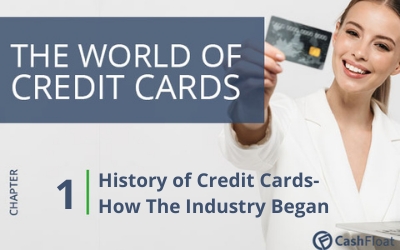
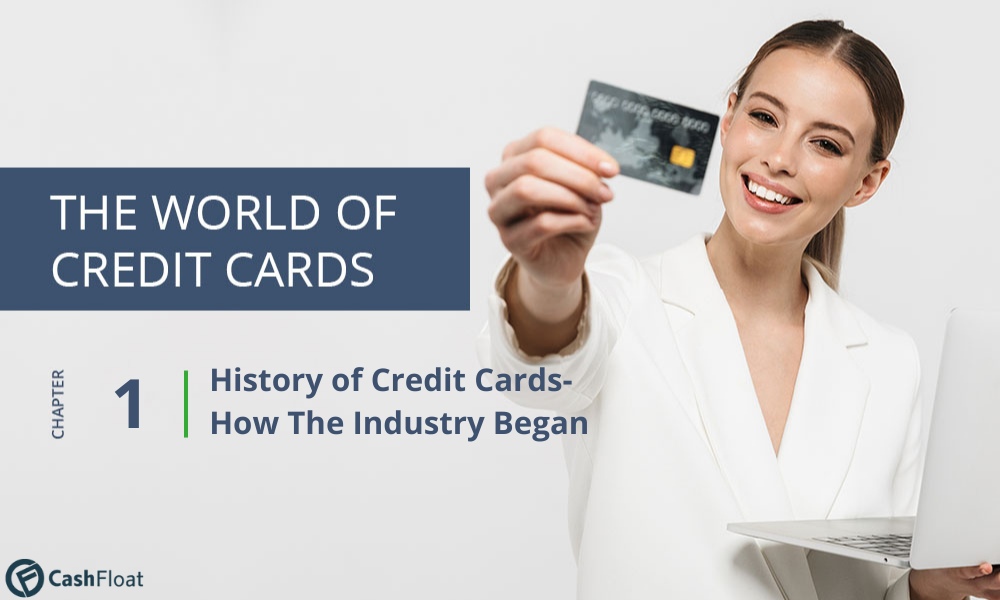
- Less than 100 years ago, most people did not have access to any credit at all
- Charge cards were one of the earliest types of credit card
- When they first came out, many retailers wouldn’t even allow payment by credit card
In a short space of time, credit cards have become an important part of the global economy which we largely take for granted. In this article, Cashfloat, a responsible online lender, tells a short story of the history of credit cards and how they evolved from being simple charge cards that were available to only a select few to the multi-billion pound business that they are today.
The History of Credit Cards
- What credit was available to ordinary people before credit cards
- How credit cards originated from stores who offered revolving credit and different types of charge card
- How American Express were so important in the development of credit cards
- The way the early credit cards worked
- How credit cards work nowadays
Have you ever wondered where credit cards come from? Anyone who came of age in the late 1960’s will be familiar with the introduction of credit cards. Most people who were born and grew up after that era will not only be familiar with credit card transactions, but will probably take this method of payment for granted. What a lot of people don’t know is that before credit cards became part and parcel of our daily lives, most people had very little access to credit at all.
Credit Before Credit Cards
If we look back at the history of credit cards, we discover something interesting. Before the mass introduction of credit cards, there were few options for people who wanted to buy an expensive item, but couldn’t pay the full amount upfront. The main 3 options that were available were:
- Hire Purchase Agreements
- Loan sharks
- Bank Overdrafts
Often, the closest people could get to credit was hire purchase agreements and these were only granted to certain categories of people. For example, for a long time, hire purchase companies did not allow women to sign agreements. Women needed the signature of a man (such as their father or husband) if they wanted to pay for an item using the instalment system. Credit for a housewife might have only consisted of running up a weekly bill at the local shop.


Following the lifting of restrictions on imported goods after the Second World War, the UK became awash with exciting new things to buy, like record players, washing machines and refrigerators. The saying at the time was, ‘bought straight from the USA’. The younger generation were encouraged to ‘buy now and pay later’. This era saw an increase in the number of goods bought on hire purchase, with young people buying a first car or furnishing their new home using this method of payment.
There were also some dubious money lenders around who charged exorbitant amounts of interest in return for a short term loan… loan sharks. Payday loans were not regulated, and this form of credit was extremely dangerous
Those citizens who had a bank account, and that was by no means the majority of working class people, might have had access to a small overdraft. Normally, in those days, the banks would only grant this after an intensive and searching face to face interview with the bank manager. Bank overdrafts are much different nowadays. Go to Chapter 15 of this guide for more information.
As was usual in this era, the richer portion of the population had access to credit, but for the ordinary people of the UK, it was a matter of saving up for things they wanted or even for things they really needed.
Credit cards began to become available to ordinary people in the late 1950s and 1960s. Before this time, people who were well off had some forms of credit available to them. The early sources of credit available to those people were usually store credit and charge cards. Charge cards were similar to credit cards, except that they had to be paid off in full and instead of being charged interest, users were charged a membership fee. These early forms of credit were what gave birth to credit cards, as we’ll explain below.
How Credit Cards First Started
Many experts on the history of credit cards believe that they evolved from charge cards which were first used in the US by early oil companies and businesses like Western Union. Once companies started to accept each other’s charge cards, the idea of having a universal card was born and this is an important part of how credit cards work.
The famous Sears store was one of the first to introduce a charge card, in 1911. While it was available to anyone, only the rich could afford it. The success of this helped to build a store, which continued right until 2003 when it was bought out by Citigroup.
The Beginning of Store Credit
In the late 1930s, the Wanamaker’s Store in Philadelphia was one of the first establishments to introduce credit. Their credit system allowed clients to receive up to four months to pay off money that they had spent in the store. Back in those days, credit was only allowed for one purchase and so customers could not continue to buy more items while they still owed money. That compares to ‘revolving credit’, where customers are allowed to make fresh purchases while they still owe money, up to a certain limit.
In the 1940s, both William Forman stores and L. Bamberger and Co first allowed true revolving credit with special cards. These cards were only for use in each individual store. Nowadays, some store credit deals allow shoppers to take credit in lots of different shops.
Airline Cards are Introduced
In early 1930s America, airlines began to accept payment for flights with air travel cards, where cardholders were given a preferential discount if they used these cards to book their flights. By 1940, the air travel card was accepted by seventeen airlines and customers could even pay for flights in instalments using the card.
After being used for air travel, charge cards began to become commonplace at hotels and restaurants.
Diners Club Cards
The story has it that the idea for the Diners Club Card came about when a man called Frank McNamara was at dinner with his wife and some business associates. He forgot his wallet and his wife had to pay for the meal. He realised that people often lack access to money and that there was an opportunity to be had.
Frank McNamara along with his associate Ralph Sneider created the Diners Club International in 1950. Joining with another similar club started by Alfred Bloomingdale, the Diner’s Club charge card came into being. Profits were generated by the annual 3 dollar fee and the 7% commission paid by participating stores and restaurants. This exclusive club initially had 27 restaurants participating in the Diners Club scheme. Members had to pay 3 dollars per year for membership, and Sneider and McNamara signed up 20,000 members in the first year.
They were soon very popular with companies, because bosses found that having a Diner’s Card allowed them to show off by wining and dining with new clients. Owning one of these cards introduced an element of kudos to some new up and coming businesses.

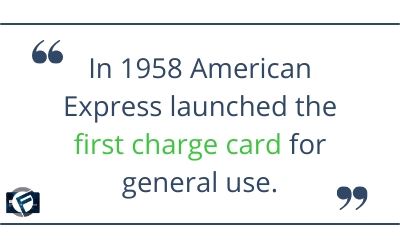
American Express Charge Cards
Within eight years of the founding of the Diners Club card, other financial institutions began to come up with similar ideas. American Express, at the time, was already a thriving company that operated a mail and money order business. This was the company that had launched traveller’s cheques as a means of making international trips easier to finance.
In 1958, American Express decided to launch a charge card for general use with there being so much demand that there was a first issue of some 250,000 before the actual launch date. The annual fee was 6 dollars, and while this card gave credit to more people than had been available before, it was still a relatively exclusive product.
As the use of American Express charge cards increased, an industry developed. With American Express leading the way, more companies started offering charge cards to more and more members of the public. During this time, credit cards evolved as new charge cards were introduced with conditions more and more closely matching those of credit cards. As the conditions came to match those of credit cards they became more and more accessible to the general public. At some point in this journey the credit card was born.
Both Diners Club International and American Express still exist today. To find out their latest charge card offers, go to Chapter 8 of this guide.
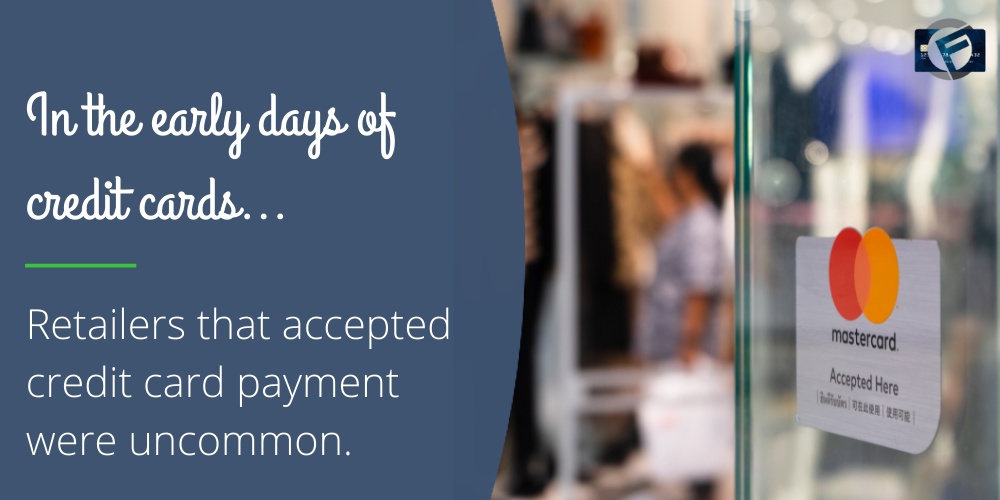
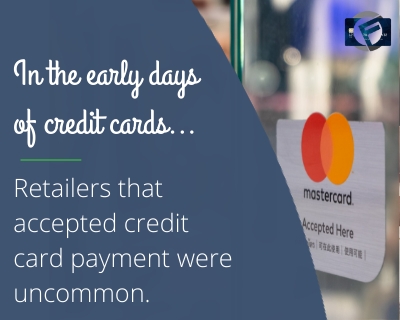
How Early Credit Cards Worked
In hindsight, the process of using an early credit card at a shop was slow and almost painful. The very first card transactions in the US involved the merchant ringing their own bank, which in turn had to contact the card issuer to confirm that the customer was creditworthy.
When cards came to the UK, transactions were also slow. First of all, you had to find a participating store which accepted the card. When you made a purchase, you placed the card in a machine which printed a flimsy paper copy with the card details. You then had to sign the paper receipt which had three copies. One for you, one for the retailer and one for the issuing bank.
The cashier or person taking your payment then compared your signature to that on the back of the card. The whole process took days before it reached the bank and arrived in your account. Each month you would receive a statement. You had to pay a minimum amount by a set date. This was and still is, for many people, 3% of the total balance or a minimum amount, nowadays of £5.00.
When you compare this process to the modern day, it’s hard to believe that it ever took off. Just like now, in the early days failure to pay or making payments after the designated date generated large fees which would rack up the amount owed.
Retailers Which Accepted Cards
While hotels, airlines and restaurants were some of the first businesses to readily accept payment by credit card, smaller retailers were reluctant to exchange these paper transactions for cash sales. The stores which did accept cards were unusual and the credit card acceptance signs over the cashiers’ till or shown in shop windows were rare. Nowadays, you see these signs everywhere and it almost goes without saying that a shop will take your card.
The benefits for the retailer were an increase in sales and soon these more than outweighed the fees that the credit company charged. The fees that credit card companies charged to shopkeepers, as well as card holders, helped to make this one of the most profitable financial businesses in the UK.
Expansion Of Credit Card Transactions
Most forward-looking businesses took on board the ever increasing use of credit cards and many moved quickly to accept credit cards so they could increase sales. Generally, as the public have taken up credit cards more and more, retailers have rushed to keep pace. However, in the past, some of the larger companies were reluctant to join the new age of credit.
One of the most reluctant was Marks and Spencer. Many people will find it surprising that they did not accept credit card transactions until the year 2000. The store did have its own charge card but eventually, due to diminishing sales, they finally lifted the ban on credit cards in the new Millennium. It took Aldi, the German retailer, until 2014 to start accepting credit cards.
These days it would be a brave retailer that refused to accept payments by credit card, and this lucrative financial business looks set to remain a major part of the UK’s financial make up.
Credit Cards Today
Credit cards have become more and more sophisticated as technology has advanced. Read on to find out more.
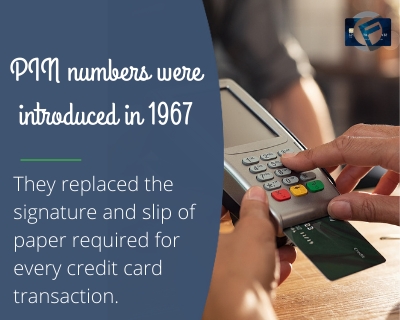
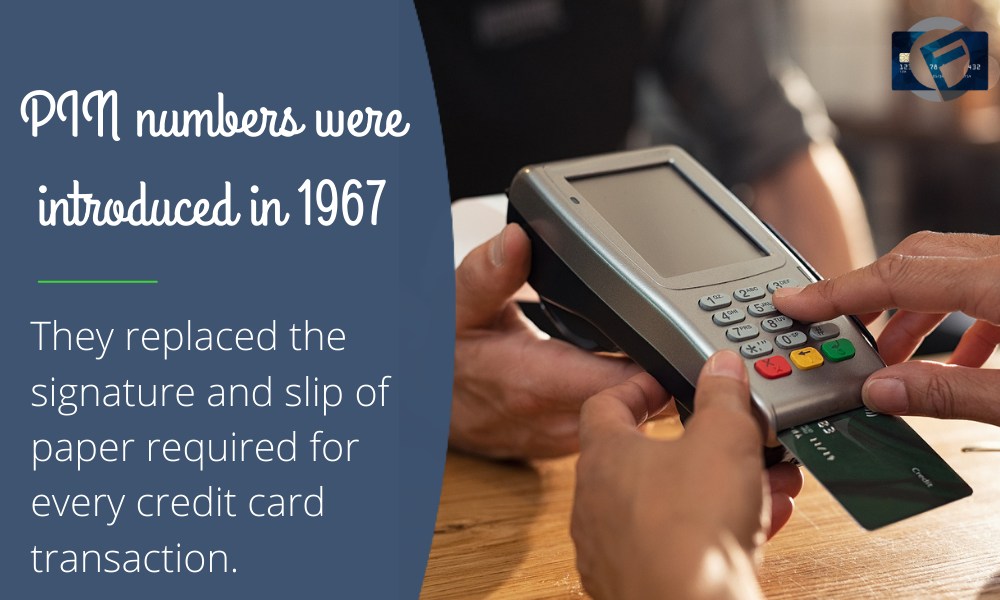
The Introduction of PIN Numbers and Advances in Technology
As the use of credit cards increased and new technology became available, cards were fitted with a magnetic strip and a PIN number was issued to the account holder. The PIN (or personal identification number) allows the account holder to use the card at an ATM or to pay for goods or services. It replaced the need for a signature and slip of paper. Banks made it clear that it was very important to keep the card and the PIN separate so that anyone finding a lost wallet could not use the card fraudulently. However, some people could not remember the PIN and there were many cases of theft when this new system was established. The PIN number that was issued could be changed at an ATM to something more memorable and a lot of people used birthdays or anniversary dates as their PIN number. Again, this proved to be simple for thieves to crack and many cases of fraud were experienced.
Most people are wise now, to the risk of theft, and choose a secure PIN number. As well as the introduction of PIN numbers, other technology, such as contactless payment has been introduced. While technology has improved the way that people use credit cards, they still work in a similar way as to how they did when they were first introduced. While there is more competition now between credit card providers to offer better deals to their customers, the basic premise is the same. Credit cards will allow you credit for a certain amount of time, but if you don’t pay it back before a certain date, you will start to be charged interest.
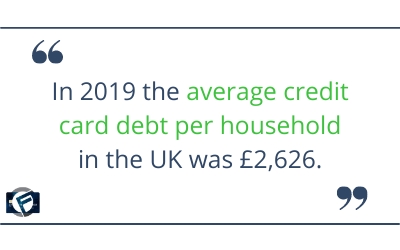

The Downsides Of Credit In The 21st Century
Naturally, there are downsides to having a credit card. We’ve seen these throughout the history of credit cards. These become apparent when you owe a large sum of money and are unable to pay off more than the minimum amount each month.
- Credit limits were too high
- Mass advertisements
Debt on credit cards became a major problem during the late 1990s and the early 2000s, with many young people receiving high credit limits and then being unable to pay off the sums due. Although companies published the interest rates for credit cards, many people only looked at the minimum amount they needed to pay each month. This led them to run up debts that became unsustainable. The habit of using one credit card to pay off another became a way of life for habitual spenders who used cards instead of cash. Credit card companies targeted young people who seemed to think that as it was not cash they were spending it did not count. This led to a situation where personal debt in the UK spiralled out of control. A similar thing was happening with pay day loans in the UK at the time; many were taking advantage of the ‘free cash’ but then could not repay their loans.
There were mass mailings of advertisements for credit card offers with many new companies springing up and taking advantage of the retailing boom of the era. This era of the history of credit cards includes one particularly expensive story: In 1958, an employee of the Bank of America sent out 60,000 genuine credit cards to the residents of Fresno in California. These paper cards had a credit limit of 300 dollars and, after some success in the first year, the following year the same employee sent out a total of two million cards. Sadly, the next year, a high percentage (20%) of the cards were used, but not enough payments came back and the bank ended up losing a total of around 8.8 million dollars. The employee also lost his job.
That particular part of the history of credit cards cannot be repeated nowadays. These days there are more stringent regulations, and unsolicited cards cannot be sent out. In addition, accepting applications for credit cards is more strictly controlled, and all finance companies and banks now use the credit rating agencies as one of the means of assessing new customers and their ability to pay on credit.
The History of Credit Cards – Summary
The next chapter goes into more detail about how credit card use developed in the US in the latter part of the 20th century. We will look, in more detail, at how the expansion of credit cards boosted the US economy from the 1970s up to the early 2000s. This expansion of credit card usage and the changing attitude that people had towards debt helped to cause the financial crisis of 2008. We will explain this history and, after that, we’ll talk about how this has shaped the way that the credit system works in America today.



